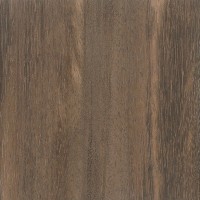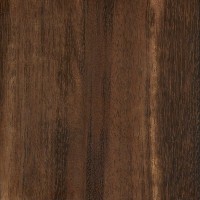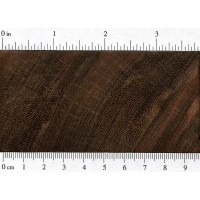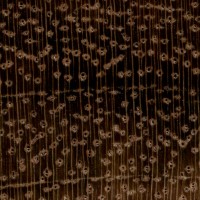 |
Common Name(s): Guatemalan Mora, Mora
Scientific Name: Possibly Inga spp. (almost universally mislabeled as Maclura tinctoria) Distribution: Guatemala Tree Size: 60-80 ft (18-25 m) tall, 2-3 ft (.6-1.0 m) trunk diameter Average Dried Weight: 57 lbs/ft3 (910 kg/m3) Specific Gravity (Basic, 12% MC): .75, .91 Janka Hardness: 2,380 lbf (10,590 N) Modulus of Rupture: 19,560 lbf/in2 (134.9 MPa) Elastic Modulus: 2,160,000 lbf/in2 (14.90 GPa) Crushing Strength: 11,710 lbf/in2 (80.8 MPa) Shrinkage: Radial: 3.4%, Tangential: 5.4%, Volumetric: 7.8%, T/R Ratio: 1.6 |
Color/Appearance: Light to medium reddish brown, with streaks of lighter and darker material.
Grain/Texture: Has a straight to interlocked grain, with a fine to medium texture.
Endgrain: Diffuse-porous; medium pores in no specific arrangement; solitary, and commonly in radial multiples of 2-3; tyloses and other deposits common; growth rings may be distinct due to seemingly marginal parenchyma; rays visible without lens; parenchyma banded, paratracheal parenchyma vasicentric, aliform (lozenge and winged), and confluent.
Rot Resistance: Guatemalan Mora is very durable and has good weathering characteristics; it is also resistant to termites.
Workability: Working this wood can be difficult due to its hardness and density, though it is reported to have little dulling effect on cutting edges. It turns well, and also takes stains, glues and finishes well.
Odor: No characteristic odor.
Allergies/Toxicity: Sap has been reported to cause dermatitis. See the articles Wood Allergies and Toxicity and Wood Dust Safety for more information.
Pricing/Availability: Guatemalan Mora should be moderately priced for an imported hardwood.
Sustainability: This wood species is not listed in the CITES Appendices or on the IUCN Red List of Threatened Species.
Common Uses: Heavy construction (within the tree’s natural range), flooring, furniture, turnings, and other small specialty wood items.
Comments: Perhaps one of the most confusing names in modern hardwood commerce is the selling of a Guatemalan wood being marketed as “Mora” with a scientific name Maclura tinctoria—both the common and scientific names are incorrect. The common name Mora has traditionally been used for an unrelated wood found in northern South America (not found in Guatemala) known by the scientific name Mora excelsa. Also, the scientific name Maclura tinctoria belongs to an unrelated Argentine variety of Osage Orange (sometimes called Fustic) with a bright yellowish color when freshly cut, aging to a russet brown upon exposure to light. The exact species of Guatemalan Mora is not known, but is suspected to be Inga species.
None available.
 |
 |
 |
 |





One more reference of Inga leiocalycina suggesting the common names in Costa Rica are guabo ron-ron, guabo colorado, cuajiniquil colorado. Could this be Guatemalan mora?
https://onfcr.org/wp-content/uploads/media/uploads/documents/ficha-tecnica-christian-zuniga-mendez.pdf
A technical sheet for Inga leiocalycina indicates it’s found in Suriname and the Amazon basin and is quite dense at 0.69 kg/m3 at 12%.
https://edepot.wur.nl/378604
Interestingly, this Costa Rican provider of mora slab lists the species as Inga leiocalycina. It does indeed look like your sample with a darker hue.
https://www.premiumwoodslabs.com/wood-specs/?species_id=gua
Hi Eric. Love you site! It’s been a helpful reference. I work in the forestry sector in Guatemala and am also interested in getting to the bottom of the Mora mystery. Out of curiosity, what led you to believe that it isn’t a sub-species or variant of Maclura tinctoria? On Guatemala’s forestry department (INAB) website, the common name “mora” is labeled as Maclura tinctoria with numerous synonyms (pasted below for reference). It is possible INAB is wrong. Cook Woods lists the yellow variant as: “Yellow Mora, Morus insignis, is a Central American hardwood from Guatemala.” This suggests that Guatemala does indeed produce… Read more »
Did you use the mechanical properties values that you have for Argentine Osage Orange for Guatemalan Mora, or are the values actually just the same?
The values really won’t be the same, so more than likely they are wrong. But to be fair, this page started out under the assumption that the wood was just a regional variant of Maclura tinctoria, which I later verified was not the case. But the ID of the wood is still a mystery — and one that I’ve not yet gotten around to addressing.
Eric, thanks for the in depth answers to Joel. Not only learning from you both, but am so appreciative for the folks who are indeed into the studies of woods.
Tsang
7/7/2019
Hi, I have been using your website for years and it is terrific! I bought the chart and I bought the book. Today I received some “Mora” wood and tried to find it in the book. Nothing in the index on Mora. So, I came upstairs and looked up “Mora Wood” on Google and there was a link to your site. Oh, Guatemalan Mora. No problem. Ran back down to the shop and looked through the index and then through the book page by page – no Mora and no Guatemalan Mora. So, I have two simple questions: a) How… Read more »
It was not included in the book because no one seems to know what in the world this wood species actually is. It is (or at least, WAS) universally mis-labeled by retailers as Maclura tinctoria, but after analyzing it, I’ve confirmed my suspicions that this ID is wrong, and the real Maclura tinctoria (also sometimes going by the common name “mora”) looks completely different. I even sent a sample of the wood into the USDA for ID and the best they could do is say that it is POSSIBLY a species of Inga.